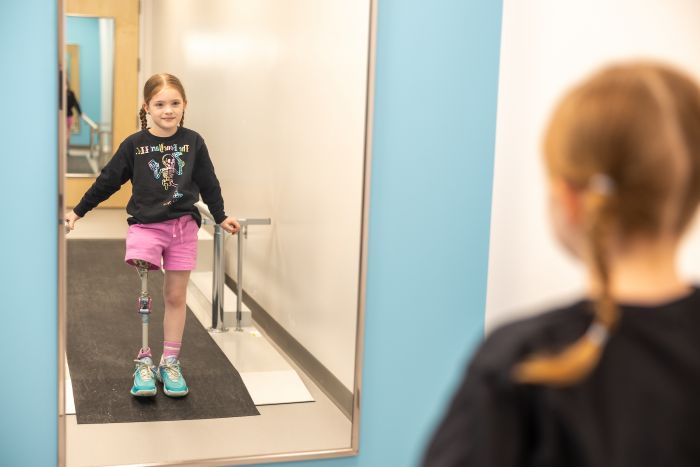Gillette Children’s has one of the nation’s highest concentrations of pediatric orthopedic surgeons — and the latest technology specifically designed to care for children who have limb differences.
These conditions include congenital disorders; disuse or overuse of bones, muscles, or joints caused by illness or disease; traumatic injuries, such as severe fractures that damage growth plates; or issues of the spine, shoulder, or hip.
“Limb differences at Gillette are approached with a multidisciplinary team. Patients and family goals are front and center,” says pediatric orthopedic surgeon Andrew Georgiadis, MD.
“We take the time to explain the pros and cons of every available treatment,” Georgiadis adds.
“Communication is paramount, and we strive to make the experience as easy as possible for the family, so they never feel like they are navigating alone.”
A complicated pregnancy, twin girls, and a pre-birth limb difference
The expertise and family-centered approach at Gillette is appreciated by parents like Katie and Eric Melquist from Lino Lakes, MN.
“We just love Gillette!” Katie proclaims. “We feel so lucky that we were connected with Gillette from day one of our daughter Harper needing care.”
In 2018, Katie was 12 weeks pregnant with twins when she experienced the first complications of her pregnancy. Tests revealed bleeding and bruising in the placenta, and Katie’s pregnancy was deemed to be high-risk.
For the next few months Katie had regular check-ups and ultrasounds to make sure things were progressing well.
At 20 weeks Katie had an anatomy scan where doctors discovered the babies were sharing a placenta and had Twin-to-Twin Transfusion Syndrome (TTTS). This rare condition can pose risks such as an imbalance in blood flow between the twins. Tests also showed one of Harper’s legs was not typically developing, and she was diagnosed with intrauterine amputation of the lower limb.
It was a tense time for the Melquist family, and Katie went into labor at 33 weeks. “The girls were born, and it really was a blur,” Katie says. Immediately after birth, the twin girls were whisked
away to the neonatal intensive care unit (NICU).
At three days old, Harper underwent a 9-hour procedure to have most of her left leg amputated and exploratory intestinal surgery.
“We basically lived in the NICU for a month,” Katie recalls. “Doctors had to amputate Harper’s leg high up in the femur. There was a lot happening with both girls.”
Gillette limb care and prosthetics for babies and children
After the stress of a complicated pregnancy and birth, the Melquist family appreciated the reassurance and care they found at Gillette.
“From the moment we walked in the door of Gillette we were impressed by how friendly and professional everyone is,” Katie says. “Harper was just six months old when we first came to Gillette. She was evaluated by an orthopedic surgeon, seen by a physical therapist, and we met with the prosthetics team,” Katie recalls.
“At six months of age Harper got an ‘itty bitty’ prosthetic leg and the physical therapy team worked with her so she could learn to crawl and move,” Katie adds.
Expert limb difference care from infancy to adulthood
Gillette orthotics and prosthetic practitioner Tara Wright was part of Harper’s care team from the beginning.
“Establishing care with the Prosthetics Clinic was an opportunity for Harper’s parents to learn about the full range of care available at Gillette for children with limb differences,” Wright says. “Our care includes surgical treatment, prostheses, and physical and occupational therapy.”
As part of the multidisciplinary team, Wright’s colleague and Gillette lead prosthetist, Michelle Hall, champions the holistic treatment plan approach of the Prosthetics Clinic as a unique benefit to patients.
“Our team of prosthetists is used to working with people throughout childhood and adulthood,” Hall says. “This gives us a unique opportunity to understand how children with limb differences grow and change throughout their lifetime. We creatively address their needs — whether that is learning to walk as a toddler, playing their first instrument or sport as an adolescent, or preparing for college or the workplace in their teens and adulthood.”
Prosthetics and limb care on the child’s terms
Hall and Wright say it’s important for children who have limb differences to get care as soon as possible so they can reach developmental milestones such as sitting, crawling, and standing.
Wright recalls Harper’s early prostheses were used for therapeutic activities and required a lot of assistance from her parents. The prosthetists and therapists at Gillette are experts in helping reluctant children become engaged with the important work of learning to be independent.
“On days that Harper did not want to participate, she would wiggle her little limb out of the prosthesis,” Wright says. “So, from the beginning, we were operating on Harper’s terms.”
With the support of her parents and the Gillette team guiding her care, Harper worked hard to become more independent and active. Now, at 7 years old, Harper enjoys impressing her Gillette care team and pushing what she can do physically.
“I’ll never forget the day Harper walked into Gillette without her walker,” Wright recalls. “She now pirouettes through the office. Thanks to the support of Harper’s parents, the care team at Gillette, and recent legislation
expanding coverage for prostheses, Harper is limited only by her imagination. In fact, we are just beginning to work on a running prosthesis for her,” Wright says.
Harper’s mom is grateful for the care and expertise her daughter has received at Gillette across orthopedic, therapy, and prosthetic services. “We might be facing some additional surgery so her prosthetic leg can fit better as she grows into a teenager,” Katie says. “We know the team at Gillette has a great plan for Harper and will be there for her into the future.”
Join Our Partners in Care Community!
Subscribe to Partners in Care Journal, a newsletter for medical professionals.
Subscribe Today Home Page
Home Page

